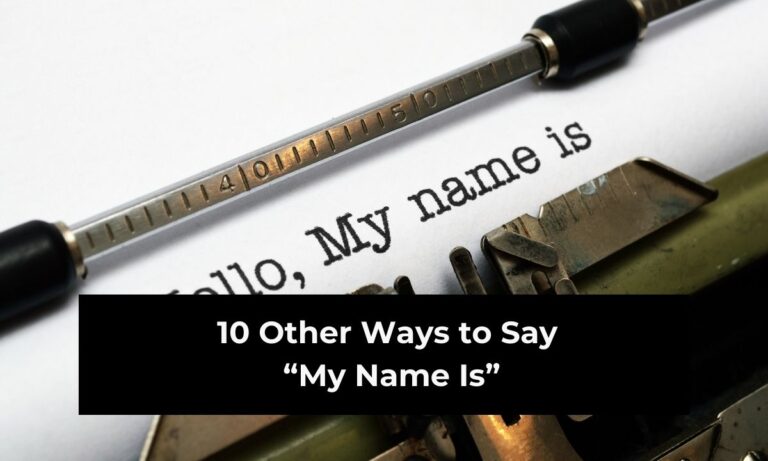When you’re writing, whether it’s for work, school, or even a personal project, the phrases you use shape how your readers connect with your ideas. Certain expressions—like “As you can see”—are so common that they sometimes lose their impact. While this phrase works fine to direct attention to a point, graph, or example, repeating it too often can make your writing feel predictable or dull.
You’ve probably noticed that the more you use the same words, the less powerful they sound. That’s why finding fresh alternatives isn’t just about improving your vocabulary—it’s about keeping your readers engaged. Choosing the right variation can also make your writing sound more natural, professional, or conversational, depending on the tone you want.
Think about it: in everyday conversations, you don’t always say the same thing in the same way. Instead, you adjust your language based on who you’re speaking to. Writing works the same way. If you’re creating a presentation for work, you may want to sound polished and professional. If you’re explaining something to a friend, you’ll likely use a lighter, friendlier expression.

That’s where this guide comes in. Below, you’ll discover 10 creative, effective, and versatile alternatives to “As you can see.” Each option comes with practical explanations, examples, and guidance on when to use them. By the time you finish reading, you’ll have a toolkit of phrases to keep your writing sharp, dynamic, and engaging.
Must Read:
Let’s dive into the list and explore how you can add variety and clarity to your writing.
1. “As Shown Here”
This phrase works perfectly when you’re pointing to a chart, diagram, image, or section of text. It directs your reader’s attention without sounding repetitive or casual.
“As shown here” is especially useful in professional settings. Imagine you’re creating a presentation for your team. Instead of always saying “As you can see on the slide,” you could write “As shown here, the data highlights a clear increase in customer engagement over the past quarter.” It feels polished and precise.
This alternative also comes across as more objective. You’re not assuming what the reader does or doesn’t see—you’re simply guiding their focus to the evidence presented. That’s why it’s often favored in reports, academic writing, or instructions where clarity matters most.
You can also use it in everyday explanations. For example, if you’re writing a blog post that includes step-by-step instructions with images, saying “As shown here in step three, the mixture begins to thicken,” helps the reader follow along naturally.
By swapping “As you can see” for “As shown here,” you create a smoother flow and a slightly more formal tone without losing readability.
2. “As Demonstrated”
If you want to highlight proof, evidence, or a clear result, “As demonstrated” is a strong choice. It implies that what you’re showing isn’t just visible—it’s backed up by something concrete.
This phrase shines in technical writing, research papers, or training material. For example: “As demonstrated in the trial results, participants who followed the new routine saw measurable improvements in just six weeks.” Notice how it emphasizes both the action and the evidence.
In less formal contexts, “As demonstrated” also works when explaining how-to processes. Let’s say you’re writing about cooking: “As demonstrated in the recipe video, folding the batter gently ensures a fluffy texture.” Here, it guides the reader while reinforcing the method’s importance.
What makes this phrase powerful is that it positions your content as credible. You’re not just pointing something out—you’re showing proof of its effectiveness. This builds trust with your audience, whether they’re coworkers, students, or casual readers.
So, the next time you want your writing to highlight evidence or authority, “As demonstrated” is an excellent substitute for “As you can see.”
3. “Clearly”
Sometimes, simplicity is the best choice. The word “Clearly” cuts right to the point, making your statement feel direct and confident.
For example, instead of saying “As you can see from the numbers, sales have improved,” you could say “Clearly, sales have improved over the past quarter.” It eliminates unnecessary words while still driving home the same point.
“Clearly” also works when you want to highlight something obvious or undeniable. If you’re writing persuasive content, it adds weight to your argument. For instance: “Clearly, adopting healthier habits leads to better energy levels and long-term wellness.”
That said, use “Clearly” thoughtfully. If you overuse it, your writing might come across as too forceful or dismissive, especially if the point isn’t obvious to your reader. The key is balance—choose it when the evidence truly speaks for itself.
This option is best for conversational writing, speeches, or articles where you want a confident tone without sounding overly formal.
4. “From This, You Can Understand”
This phrase takes a slightly more explanatory approach. Instead of pointing out what’s visible, it connects what’s being shown to what the reader should grasp.
For instance, if you’re teaching a concept, you might say: “From this, you can understand how small daily savings lead to big results over time.” It doesn’t just highlight the evidence—it tells the reader what the takeaway should be.
This is particularly effective in educational content, tutorials, or motivational writing. It guides the reader beyond just looking and helps them interpret the information in a meaningful way.
Another example might be: “From this, you can understand why collaboration often leads to more innovative solutions.” The phrase naturally transitions from observation to insight.
The strength of this alternative lies in its helpful tone. It feels like you’re walking alongside the reader, ensuring they grasp the point, rather than simply pointing something out.
5. “It’s Evident That”
When you want your writing to sound authoritative yet conversational, “It’s evident that” is a great choice. It strikes a balance between confidence and clarity.
For example: “It’s evident that strong communication improves workplace relationships.” This phrasing feels firm, but not overly formal. It tells your reader the conclusion is obvious without sounding blunt.
“It’s evident that” works in a variety of settings—from academic writing to business reports to blogs. It emphasizes clarity while keeping the tone approachable. If you’re writing persuasive content, it can help underline key arguments effectively.
Consider this example in an article about gardening: “It’s evident that regular watering helps plants thrive, especially during hot summer months.” The phrase smoothly conveys both observation and conclusion.
By choosing “It’s evident that,” you bring an authoritative voice to your writing while still maintaining accessibility.
6. “As Illustrated”
Visuals often speak louder than words, and “As illustrated” is the perfect phrase to use when referencing images, charts, or diagrams.
For instance, if your article includes a chart, you might write: “As illustrated in the graph, customer satisfaction ratings increased steadily over the year.” The phrase signals that the reader should look at the visual for clarity.
This alternative is particularly effective in design, research, and educational materials where visuals are central to understanding. Even outside professional contexts, it works well. Imagine writing a craft blog: “As illustrated in the step-by-step images, folding the fabric this way creates a cleaner finish.”
The key advantage of “As illustrated” is that it smoothly integrates visuals into your explanation. It reinforces the relationship between the text and the supporting image, helping the reader follow along easily.
7. “Notice That”
If you want to grab your reader’s attention and get them actively engaged, “Notice that” is a strong choice. It’s direct, conversational, and draws the reader into the process.
For example: “Notice that the colors gradually shift from warm to cool tones in this design.” By using this phrase, you’re not just pointing something out—you’re inviting the reader to observe and connect with the details.
“Notice that” is especially useful in teaching, writing tutorials, or giving presentations where you want the audience to pay attention to a specific element. It creates a sense of interaction, almost as if you’re guiding them step by step.
You can also use it in everyday explanations, like: “Notice that the recipe calls for unsalted butter to balance the flavors.” This makes the information feel more personal and practical.
The charm of this phrase lies in its ability to create engagement. It shifts the focus from passive reading to active noticing.
8. “As Evidenced By”
This phrase is particularly strong when you want to link your statement directly to proof or real-world results.
For example: “As evidenced by the recent study, consistent exercise reduces stress levels significantly.” The phrase ties your point to concrete evidence, making your writing more persuasive and credible.
In professional or academic contexts, “As evidenced by” reinforces authority. You’re not just claiming something—you’re showing it’s backed by facts, research, or data. This makes it ideal for reports, essays, or persuasive articles.
Even in casual writing, it works well when you want to highlight proof. For instance: “As evidenced by the overflowing shelves, she had a true love for books.” Here, the phrase adds depth and supports the observation with a vivid image.
Using “As evidenced by” positions your writing as thoughtful and reliable. It’s a great way to build trust with your readers.
9. “This Shows That”
Sometimes, you need a simple transition that connects evidence with meaning. “This shows that” does exactly that.
For example: “This shows that small daily efforts can create long-term habits.” It’s clear, concise, and naturally bridges what’s visible with the conclusion you want the reader to draw.
This phrase is effective in persuasive writing, blogs, and presentations because it moves beyond pointing things out. Instead, it highlights the bigger picture or takeaway.
In a science explanation, you might write: “This shows that photosynthesis plays a vital role in sustaining life on Earth.” The phrase directly ties observation to conclusion.
The beauty of “This shows that” lies in its versatility. You can use it in both casual and formal writing, making it a reliable replacement for “As you can see.”
10. “Observe That”
“Observe that” is a slightly more formal and instructional phrase. It’s often used in academic, technical, or professional settings where precision matters.
For example: “Observe that the system automatically adjusts when new data is entered.” It signals the reader to focus on something specific and notice how it works.
In educational contexts, this phrase can help guide learners step by step. For instance: “Observe that when you adjust the angle, the shadow becomes sharper.” It encourages active engagement and careful attention.
While “Observe that” feels more formal than some of the other options, it’s still approachable when used in the right context. It positions you as a guide, leading the reader to notice details they might otherwise overlook.
If you want to sound precise, thoughtful, and instructional, “Observe that” makes an excellent alternative.
Conclusion
Language is full of choices, and the words you select shape the way your readers experience your writing. While “As you can see” is a familiar and functional phrase, overusing it can make your writing feel repetitive or flat. By exploring alternatives like “As demonstrated,” “Clearly,” or “Notice that,” you give yourself the flexibility to adapt your tone and better connect with your audience.
Each alternative we’ve covered brings its own strength—whether it’s adding authority, encouraging engagement, or creating smoother transitions. The key is to choose the phrase that matches both your context and your audience.
Next time you catch yourself writing “As you can see,” pause and think: is there a fresher, more effective way to say this? With the ten options in this guide, you’ll never be stuck with just one choice. Instead, you’ll have a toolkit of expressions to make your writing more dynamic, engaging, and memorable.
Words are powerful, and when you use them with intention, your message becomes much more impactful. The more variety you bring into your communication, the more your readers will stay engaged—and the better your writing will shine.
FAQs
1. Why should I avoid overusing “As you can see”?
Because it can make your writing sound repetitive or assume too much about the reader’s perspective. Alternatives keep your content fresh and engaging.
2. Can I use these alternatives in formal writing?
Yes. Phrases like “As demonstrated,” “As evidenced by,” and “Observe that” are especially suited for formal or academic contexts.
3. Which alternative is best for casual writing?
Options like “Clearly” or “Notice that” work well in casual, conversational writing.
4. Do these alternatives change the meaning of my sentence?
Not significantly, but they can change the tone. Some sound more formal, while others feel friendlier or more persuasive.
5. How do I know which phrase to choose?
Think about your audience and purpose. For formal reports, use precise alternatives. For blog posts or casual explanations, stick to more conversational ones.





